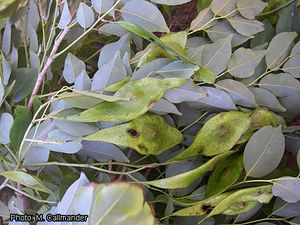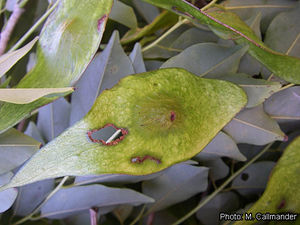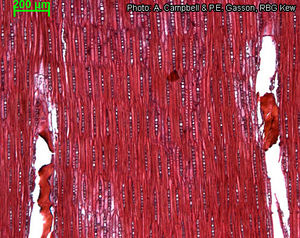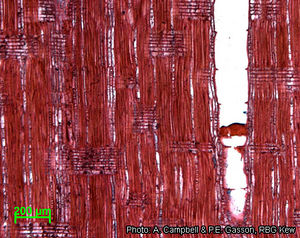Dalbergia greveana (PROTA)
Introduction |
| General importance | |
| Geographic coverage Africa | |
| Geographic coverage World | |
| Medicinal | |
| Timber | |
| Ornamental | |
| Conservation status | |
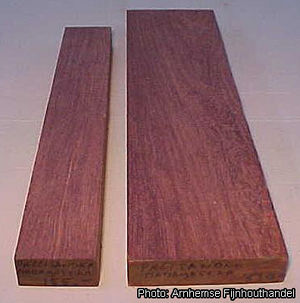
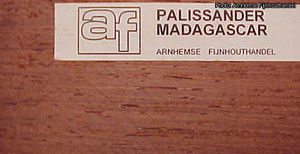
Dalbergia greveana Baill.
- Protologue: Bull. Mens. Soc. Linn. Paris 1: 436 (1884).
- Family: Papilionaceae (Leguminosae - Papilionoideae, Fabaceae)
Vernacular names
- French rosewood, Madagascar rosewood (En).
- Palissandre violet, palissandre de Madagascar (Fr).
Origin and geographic distribution
Dalbergia greveana is endemic to Madagascar, where it is widespread in the western part.
Uses
The wood is one of the so-called rosewoods (‘Madagascar rosewood’, ‘palisander’), which are much in demand for cabinet making, furniture, marquetry and parquet flooring. It is one of the favoured woods for musical instruments, not only because of its beautiful colour and venation, but also because of its clearness of tone. It is also suitable for interior trim, joinery, ship and boat building, vehicle bodies, poles and piles, precision equipment, carvings, toys and novelties, sporting goods, handles, ladders, turnery, pattern making, veneer and plywood. The wood is used locally in Madagascar, e.g. for construction and paddles and as firewood. The Mikea people of south-western Madagascar rub pieces of branches on stones with water to produce a paste which is applied to the face as a medicine against various ailments; Dalbergia greveana is a sacred tree for these people.
Production and international trade
Formerly Dalbergia greveana timber represented the bulk of timber exports from western Madagascar, and is still exported in limited amounts. The wood is traded on the international market, usually in small amounts and at high prices, for special applications such as ornaments, turnery and musical instruments. In recent years it has replaced Brazilian rosewood (from Dalbergia nigra (Vell.) Benth.) because this South-American species has been included in Appendix I of CITES as an endangered species. It is often traded as quarter-sawn pieces of comparatively small dimensions.
Properties
The heartwood is purplish brown, often with darker stripes, and distinctly demarcated from the lighter sapwood. The grain is generally straight, texture fine to moderately fine and even.
The wood is heavy, with a density of about 1080 kg/m³ at 12% moisture content; it is very hard. It should be air-dried with great care because it is liable to checking and splitting. Before air-drying logs should preferably be quartersawn. Turned pieces used for precision equipment or musical instruments should be dried thoroughly to avoid distortion. However, the reported rates of shrinkage are moderate, from green to oven dry about 3.3% radial and 5.4% tangential. Once dry, the wood is very stable in service.
At 12% moisture content, the modulus of rupture is 181–226 N/mm², compression parallel to grain 98 N/mm², cleavage 21.5 N/mm, Janka side hardness 13,350 N and Chalais-Meudon side hardness 18.6.
The wood works well, both with hand tools and machine tools, but it blunts sawteeth rapidly. For nailing and screwing pre-boring is needed. Painting and varnishing gives moderate results because of the oily surface of the wood, and the gluing properties are moderate. The wood is suitable for sliced veneer. It is durable, being resistant to termite and Lyctus attacks, but only moderately resistant to marine borers. The heartwood is very resistant to treatment with preservatives.
Dichloromethane and methanolic extracts of Dalbergia greveana bark showed activity against gram-positive bacteria.
Adulterations and substitutes
The wood of several other Dalbergia species from Madagascar is also traded as Madagascar rosewood or palisander.
Description
- Deciduous small to medium-sized tree up to 15(–20) m tall; bole often short and crooked, up to 50 cm in diameter; bark whitish to blackish grey, smooth to rough; young branches glabrous.
- Leaves arranged spirally, imparipinnately compound with 7–9(–11) leaflets; stipules small, caducous; petiole and rachis slightly hairy to glabrous; petiolules 3–8 mm long; leaflets alternate, ovate to elliptical or almost circular, (2–)2.5–6 cm × (0.5–)1.5–3 cm, thinly leathery, minutely hairy to glabrous below. Inflorescence a terminal or axillary panicle 5–15 (–20) cm long, with slightly coiled final divisions, hairy; bracts persistent.
- Flowers bisexual, papilionaceous, 3–4.5 mm long; pedicel c. 0.5(–1.5) mm long; calyx campanulate, 2–3 mm long, lobes shorter than tube, lower lobe slightly longer, upper lobes fused; corolla whitish becoming cream-coloured, with broadly obovate to violin-shaped standard and clawed wings and keel; stamens 10, fused into a tube, but free in upper part; ovary superior, with distinct stipe at base, style short.
- Fruit a flat, elliptical to rhombic pod 3–6.5 cm × 1–2.5 cm, with short stipe 4–5 mm long, yellowish brown, indehiscent, usually 1-seeded.
- Seed kidney-shaped, c. 8 mm × 4 mm, reddish brown.
Other botanical information
Dalbergia is a large pantropical genus comprising about 250 species. Tropical Asia and tropical America have about 70 species each, continental Africa about 50 and Madagascar slightly over 40. In Madagascar many Dalbergia species produce high-quality wood.
Dalbergia humbertii
Dalbergia humbertii R.Vig. may resemble Dalbergia greveana, but differs in more numerous leaflets (11–15) and larger fruits. Dalbergia humbertii is mainly found in the Ankarana Massif in northern Madagascar, and yields a good-quality rosewood.
Dalbergia suaresensis
Dalbergia suaresensis Baill. is also close to Dalbergia greveana, and has the same number of leaflets as Dalbergia humbertii, but smaller fruits than the latter species. Dalbergia suaresensis is restricted to the area around Antsiranana in northern Madagascar, and the wood is used in cabinet making.
Dalbergia humbertii and Dalbergia suaresensis are both classified as endangered in the IUCN Red list.
Anatomy
Wood-anatomical description (IAWA hardwood codes):
- Growth rings: (1: growth ring boundaries distinct); (2: growth ring boundaries indistinct or absent).
- Vessels: 5: wood diffuse-porous; 13: simple perforation plates; 22: intervessel pits alternate; 23: shape of alternate pits polygonal; 26: intervessel pits medium ( 7–10 μm); 29: vestured pits; 30: vessel-ray pits with distinct borders; similar to intervessel pits in size and shape throughout the ray cell; 42: mean tangential diameter of vessel lumina 100–200 μm; 43: mean tangential diameter of vessel lumina ≥ 200 μm; 45: vessels of two distinct diameter classes, wood not ring-porous; 47: 5–20 vessels per square millimetre; 58: gums and other deposits in heartwood vessels.
- Tracheids and fibres: 61: fibres with simple to minutely bordered pits; 66: non-septate fibres present.
- Axial parenchyma: 77: axial parenchyma diffuse-in-aggregates; 80: axial parenchyma aliform; 82: axial parenchyma winged-aliform; 84: axial parenchyma unilateral paratracheal; (86: axial parenchyma in narrow bands or lines up to three cells wide); (89: axial parenchyma in marginal or in seemingly marginal bands); 90: fusiform parenchyma cells; 91: two cells per parenchyma strand.
- Rays: (96: rays exclusively uniseriate); (97: ray width 1–3 cells); 104: all ray cells procumbent; 115: 4–12 rays per mm.
- Storied structure: (118: all rays storied); (119: low rays storied, high rays non-storied); 120: axial parenchyma and/or vessel elements storied; (122: rays and/or axial elements irregularly storied).
- Mineral inclusions: 136: prismatic crystals present; 142: prismatic crystals in chambered axial parenchyma cells.
Growth and development
Dalbergia greveana flowers from October to April.
Ecology
Dalbergia greveana occurs in deciduous, seasonally dry forest and woodland, sometimes as a shrub in grassland, up to 800 m altitude. It is found on various soils, from sandy to limestone-derived and ferrallitic.
Propagation and planting
Natural regeneration of Dalbergia greveana appears to be poor in comparison to other Dalbergia spp. from western Madagascar, although in Morondava region the trees were found to be prolific seed bearers with abundant natural regeneration.
Genetic resources
Although Dalbergia greveana is still widely distributed in western Madagascar, its population has much declined. It is selectively felled for its valuable timber and its habitat is under pressure. It is included in the IUCN Red list of threatened species, where it is classified as a lower-risk species, but close to vulnerable.
Prospects
Dalbergia greveana seems to be overexploited, and may soon disappear from the timber market because of stand depletion. Protection of remaining stands is needed, and Dalbergia greveana may only have a role as timber of importance in the future if plantations are successful, or if the timber is sustainably harvested from natural forest. This will probably allow only very low yield levels because trees presumably grow slowly. However, research into propagation techniques and proper management methods seems worthwhile in the light of the excellent properties of the wood. The comparatively small size and often poor shape of the bole is a drawback.
Major references
- Bolza, E. & Keating, W.G., 1972. African timbers: the properties, uses and characteristics of 700 species. Division of Building Research, CSIRO, Melbourne, Australia. 710 pp.
- du Puy, D.J., Labat, J.N., Rabevohitra, R., Villiers, J.-F., Bosser, J. & Moat, J., 2002. The Leguminosae of Madagascar. Royal Botanic Gardens, Kew, Richmond, United Kingdom. 750 pp.
- Sanda, F., 2004. Conservation et valorisation des Dalbergia (Fabaceae) de Madagascar par micro propagation in-vitro et recherché d’activité anti-microbienne. Mémoire pour l’obtention du diplôme d’étude approfondie, Département de Biologie et Ecologie végétale, Faculté des Sciences, Université d’Antananarivo, Madagascar. 45 pp.
- Takahashi, A., 1978. Compilation of data on the mechanical properties of foreign woods (part 3) Africa. Shimane University, Matsue, Japan, 248 pp.
Other references
- Boiteau, P., Boiteau, M. & Allorge-Boiteau, L., 1999. Dictionnaire des noms malgaches de végétaux. 4 Volumes + Index des noms scientifiques avec leurs équivalents malgaches. Editions Alzieu, Grenoble, France.
- Deleporte, P., Randrianasolo, J. & Rakotonirina, 1996. Sylviculture in the dry dense forest of western Madagascar. In: Ganzhorn, J.U. & Sorg, J.P. (Editors). Ecology and economy of a tropical dry forest in Madagascar. Primate Report 46–1. German Primate Center, Göttingen, Germany. pp. 89–116.
- du Puy, D., 1998. Dalbergia greveana. In: IUCN. 2006 Red list of threatened species. [Internet] http://www.iucnredlist.org. November 2006.
- InsideWood, undated. [Internet] http://insidewood.lib.ncsu.edu/search/. May 2007.
- Stiles, D., 1998. The Mikea hunter-gatherers of southwest Madagascar: ecology and socioeconomics. African Study Monographs 19(3): 127–148.
Author(s)
- R.H.M.J. Lemmens, PROTA Network Office Europe, Wageningen University, P.O. Box 341, 6700 AH Wageningen, Netherlands
Correct citation of this article
Lemmens, R.H.M.J., 2007. Dalbergia greveana Baill. In: Louppe, D., Oteng-Amoako, A.A. & Brink, M. (Editors). PROTA (Plant Resources of Tropical Africa / Ressources végétales de l’Afrique tropicale), Wageningen, Netherlands. Accessed 6 March 2025.
- See the Prota4U database.


